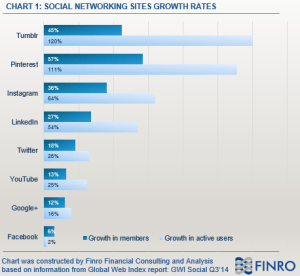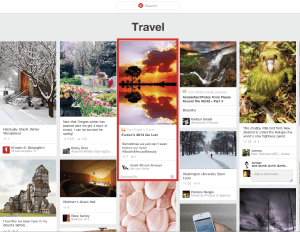Pinterest: Don’t Forget to Pin it on the Winner’s Board

Pinterest’s journey in the digital age is just beginning, and by creating significant value for both general users (i.e., consumers) and businesses, it’s certainly positioning itself for long-term success.
In October, it’ll be my wife’s birthday, and a couple years ago, I would have gone through the long and highly stressful process of:
- Guessing what she likes. Does she want to take a trip somewhere? Would she want a necklace? What about a new dress?
- Figuring out her “style preferences.” Are crop-tops in these days? Does she still like white gold necklaces, or is she becoming a fan of the new rose gold trend?
- Searching through dozens of websites and or/stores to find that “it” piece. Does Macy’s even have what I want? Should I think about buying a gift from somewhere that allows her to easily return it if she doesn’t like it?
- Planning how to present the gift to her in a creative and caring way. Should I plan a scavenger hunt for her? What other cool ways can I make this gift-giving process a little more exciting, while making her realized I really tried this year (as if I hadn’t the years before).
These days, my life has become infinitesimally easier – THANK YOU PINTEREST (and yes, I absolutely needed to capitalize, bold, and underline that comment).
Pinterest is a content discovery platform that users use to bookmark (“Pin”) pictures of interesting items they find online – from products and recipes to anniversary and wedding ideas. These pictures are all organized onto user’s Boards based on specific categories/tags the user designates to the pictures (e.g., my wife’s board conveniently includes “need to buy” and “gifts” categories). But Pinterest doesn’t just allow you to view the Boards of people within your social network. You can see almost anyone’s Board, which has been instrumental for me as I can quickly (through one website) search and choose romantic date activities (namely DIY activities) to spice things up every now and then.
The reality is that Pinterest has become one of the great and highest growing (Exhibit 1) social network platforms in the world, and it’s because it creates value for everyday users by:
- Serving as an inspiration board. When I’ve got some uncooked chicken left in the fridge, I occasionally search through Pinterest to find some great-looking dishes that can get my creative juices flowing.
- Allowing individuals to connect with others. When my wife was planning our wedding, she and her bridesmaids constantly shared their favorite pictures for flower arrangements, table cloths, etc.
- Understanding what products, dishes, and activities (to name a few) your friends like. I actually used this to find out what style of engagement ring my wife liked (it was pretty clear she wanted something with a thin band).

However, it’s not just the digital consumers receive value from Pinterest, businesses have also benefitted from the platform, since it:
- Advertises company products (seamlessly and almost invisibly) and helps generate revenue. Many of the Pins posted on the site are “Promoted Pins,” which are advertised products that fall into the categories users search. However, these Pins don’t look like your traditional advertisement; you probably wouldn’t even notice the ad (Exhibit 2) unless you really liked and clicked on the product. Further, with its new “Buy” feature, users can directly buy items from their Pinterest Boards. Companies are now more likely to receive sales from these ads, as they do not lose potential buyers who prefer not to switch programs, search for the item, and then buy.
- Enables companies to track popularity of their goods. REI and Nordstrom have leveraged Pinterest to determine what they sell – both in stores and online, based on what users like, share, and pin.
- Increases online exposure via SEO optimization. When companies add their products to Pinterest, the pin descriptions enable companies to have an optimized online search presence.
 Exhibit 2. Pinterest tries to almost secretly show advertisements, as users only notice ads if they read the light grey “Promoted Pin” text at the bottom of the image.
Exhibit 2. Pinterest tries to almost secretly show advertisements, as users only notice ads if they read the light grey “Promoted Pin” text at the bottom of the image.
As Pinterest grows its user base (now at 72.8 MM users), the platform provides companies with easy access to numerous consumers, and because of this, Pinterest is now positioning itself capture the value of that community. By 2016, analysts estimate that Pinterest will capture over $500 MM in ad revenue. And while the company currently does not take a percentage or fixed sum from sales generated by the “Buy” button, it certainly could do so in the future, should it make business sense.
Pinterest’s journey in the digital age is just beginning, and by creating significant value for both general users (i.e., consumers) and businesses, it’s certainly positioning itself for long-term success. For me, Pinterest has been a lifesaver. So, once again… thank you Pinterest. You’re a winner in my books!



Great post! I am a recent convert to Pinterest, and I absolutely agree about it being a winner in the digital age. When I first heard about Pinterest a while back, the idea initially sounded idiotic to me: “in the age of twitter, Facebook, etc, why do I need an electronic cork board?” Or so I thought. It wasn’t until this summer, when I started a collection of recipes on Pinterest, that I finally understood its power. You are totally right that it creates a effortless platform for users to store and share information. In addition, the ad placements are truly seamless. I may have already been bombarded with lots of company advertising, but, even as someone who is keenly aware of product placement, I rarely noticed ads – the content just all seemed interesting to me. Further, as any good social media company does, the endless list of posts that fit my interest is surely addicting – I have spent way too many hours scrolling down the pages!
When Pinterest first launched, I was an avid user! I would scroll through tons and tons of pins. I repinned pins and even downloaded the chrome extension to pin images from other sites. Then I noticed I stopped pinning as much because there wasn’t anything to do once I pinned something. Since most of the things I pinned were clothing, I was often frustrated that I couldn’t buy the items due to not knowing the brand. I think Buyable Pins was the last step for Pinterest to complete the product experience not only for the users but also advertisers. Now businesses can sell them through the interface, which is especially helpful for small businesses who may not have fully developed ecommerce capabilities.
Thanks for the great post on Pinterest! I am a user of Pinterest but I must admit it’s not one of my most visited social media sites. I think one of the things that I love about it is that I can so easily interact with people that are outside of my social network and come and go as I please without feeling like I’m “missing out” on anything. I had no idea that they had grown so fast nor that they had sponsored ads. I really like that I can use the site without feeling like I’m just looking at paid ads. I do get nervous though that people will get bored of the site if Pinterest doesn’t add new and different features. It will be interesting to see if they can continue to win in the social media world over the next decade.